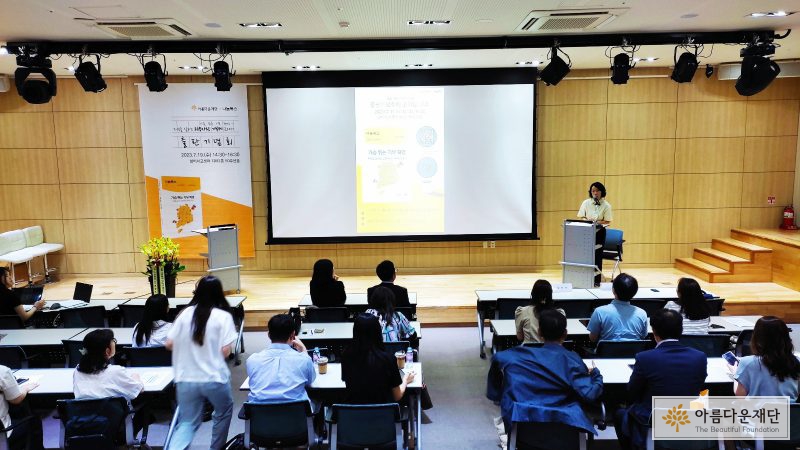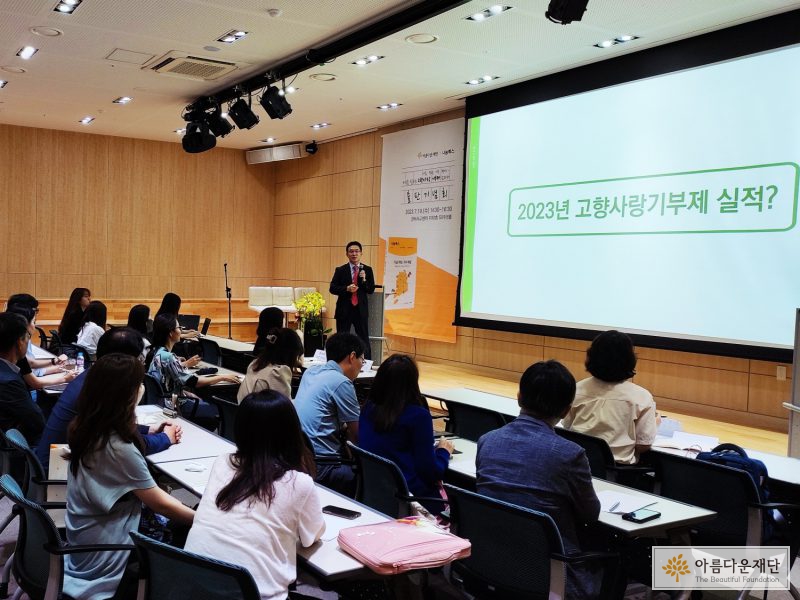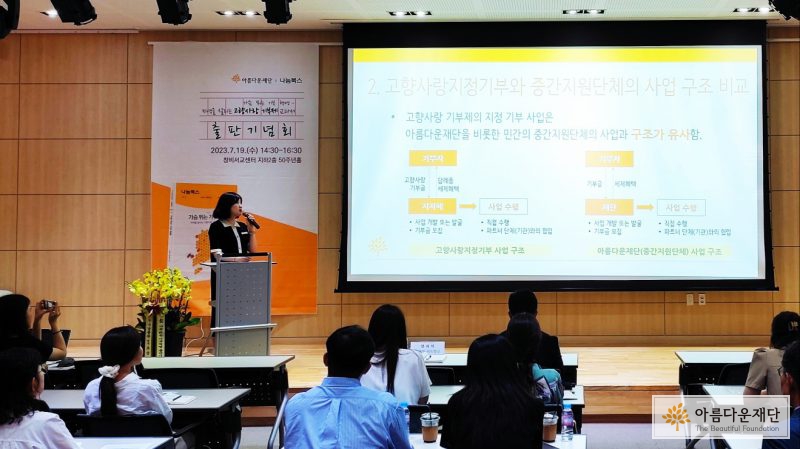On July 19th, the publication celebration for the 17th Nanum Books “Throbbing Revolution of Donation: A Textbook for Hometown Love Donation which Regenerates Cities and Provinces” was held in Seoul. During the event, two presenters explained the concept of the Hometown Love Donation and how non-profit organizations can utilize it.
1. Author Shin Seungkeun, <Hometown Love Donation, an Alternative for Sustainable Local Development>
The “Hometown Love Donation” is a scheme where donors can contribute to their hometown or a desired region, excluding their current residential address. Under this system, donors are eligible not only for tax deductions on their donations but also for receiving gifts in return. Currently, South Korea is facing a crisis of local extinction due to a declining birth rate and an aging population. As a response to this issue, the “Hometown Love Donation” was implemented on January 1, 2023.
By implementing the “Hometown Love Donation,” local governments experience an increase in donation revenues, which, in turn, leads to an increased workload. However, there are limitations to recruiting additional personnel to handle the increased workload efficiently. On the contrary, private foundations, non-profit organizations, and social economy organizations possess the expertise and experience gained from working at the grassroots level to effectively address regional issues. Therefore, there is a need to continuously cultivate tailored talents in the private sector who have expertise in local government characteristics and donation culture to cope with the expected increase in demand for donors and donation fund management. This underscores the importance of organic communication and cooperation between the private and public sectors.
2. Lee Hyung Myung, Team Leader of Major Gift Team at The Beautiful Foundation , <How to Utilize Hometown Love Donation as a NPO>
1) The Need for Proposing Designated Donation Projects for the Hometown Love Donation
With the implementation of the Hometown Love Donation for the first time this year, local government officials responsible for managing the Hometown Love Donation are facing the greatest challenge of developing and discovering designated donation projects, along with selecting gifts for donors. Developing and discovering projects that can attract the interest and empathy of donors is crucial for achieving successful recruitment outcomes.
|
General Hometown Love Donation |
Designated Hometown Love Donation |
|
Donors choose a specific local government to donate to The donated funds are used for comprehensive purposes. |
Donors choose a specific local government project to donate to. The donated funds are used for a specific purpose (e.g., project). |
As mentioned in the table above, the designated donation has the advantage that the donor can directly select a project according to the purpose of the donation.
2) Comparison of the Hometown Love Designated Donation and Non-profit Intermediary Organizations’ Project Structures
The designated donations under the Hometown Love Donation share similarities with projects organized by private non-profit intermediary organizations. Private non-profit organizations like the Beautiful Foundation have been collecting donations and developing partnerships and projects ahead of local governments. They have accumulated valuable expertise, making them a good reference for local governments.
3) Proposal for Non-profit Organizations’ Participation in the Hometown Love Donation
Non-profit organizations propose three strategies for their participation in the Hometown Love Donation. Firstly, they aim to share their fundraising know-how, as fundraising for the Hometown Love Donation requires unique and specialized fundraising activities different from revenue-generating activities or tax collection. Efforts should be made to establish a proper culture of donation and stabilize the Hometown Love Donation.
Secondly, they propose sharing their expertise in project development and relevant case studies. Local issues, often difficult to address through the general budgets of local governments, are suitable for the designated donation projects under the Hometown Love Donation. Non-profit organizations have been handling such projects for a long time, which allows them to provide professional knowledge and case studies.
Lastly, they suggest forming partnerships between non-profit intermediary organizations and local governments. Private intermediary organizations can assist local governments in finding suitable local projects and partner organizations, or they can actively participate as partners in designated donation projects by directly implementing them in cooperation with the government.
4) Representative business proposal example: Inclusive Indoor Playground for All Children to Play Together Without Discrimination
Article 31 of the UN Convention on the Rights of the Child states, “Children have the right to rest and leisure, to engage in play and recreational activities appropriate to the age of the child.” The Beautiful Foundation has been supporting outdoor playground projects for children with and without disabilities since 2006. Starting in 2022, we have developed a manual for creating inclusive indoor playgrounds and established operational guidelines for such spaces. In 2023, to promote the right to play and emotional integration for children with and without disabilities, we are actively pursuing the construction and establishment of an inclusive indoor playground (named “Shin Tree Park Integrated Inclusive Indoor Playground”) within the Shin Tree Park, in collaboration with the Seoul Metropolitan Government and Yangcheon-gu district. This project signifies the first public-private cooperation for creating an integrated indoor playground in South Korea.
|
The Beautiful Foundation |
Planning and execution of support projects and donations after establishing an indoor playground in Yangcheon-gu |
|
Seoul |
Support projects in environmental development and business consulting |
|
Yangcheon-gu |
Providing buildings and land, followed by actual operation after establishing the playground |
Local governments have embarked on these projects to realize the rights of children to play and address the policy challenges of the national child-friendly policy. The aim is to improve awareness so that future generations do not perceive differences between individuals with and without disabilities as a form of discrimination. Thus, these projects were initiated to create an inclusive indoor playground, transcending the boundaries between children with and without disabilities, where all children can freely interact without discrimination based on disabilities. The lack of social awareness about the right of children with disabilities to play and the difficulties they face in accessing play spaces (such as parks and playgrounds) for children with disabilities was recognized, leading to the planning of an integrated play area for children with and without disabilities.
Rather than providing high-value gifts to donors who contributed to the funding necessary for establishing this space (the inclusive indoor playground within Shin Tree Park), the focus of the proposal is to emphasize the “social change” achieved through support projects. It is deemed essential to continuously inform the public about the progress of the project and provide transparent reports on the project’s operations. Therefore, there are plans to conduct donor outcome reporting, including project achievements and the “spreading of social impact.” In addition, participation programs such as a Donor Wall, a playground-naming competition, and donor engagement events (e.g., mural painting events) are anticipated to express gratitude to the donors.
5) A Request to Local Governments
It is crucial to leverage the experiences and know-how of non-profit organizations that have been working for a long time to solve local issues, similar to the Hometown Love Designated Donation. Close collaboration with various stakeholders within the local community is essential. Furthermore, there is an expectation that the utilization of the Hometown Love Donation will lead to the birth of a new model of cooperation between local governments and private non-profit organizations, where they can work together toward common goals.
Closing
Currently, the imbalance in financial resources between local governments in Korea is deepening, leading to ongoing efforts to secure local government finances through the exploration of new funding sources. As an alternative, the “hometown love donation” has been proposed as a means to alleviate the financial disparities between regions, and various local governments are planning projects utilizing this. This book introduces successful cases of Japan effectively utilizing the “hometown tax” and presents strategies and insights for implementing the “hometown love donation” in Korea, tailored to our conditions. It is hoped that this book will become a practical textbook for officials in charge of the “hometown love donation” in local governments to reference. Furthermore, even after implementing the, it is essential to maintain continuous interest and conduct systematic and specific research and analysis. Discussions should cover policy implementation, performance monitoring, and setting future policy directions to ensure the stable establishment of the “hometown love donation”.



댓글 Comment